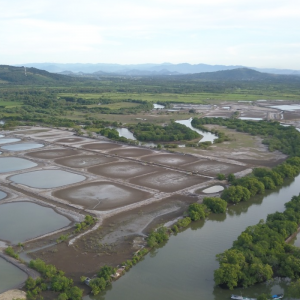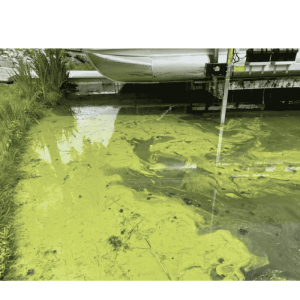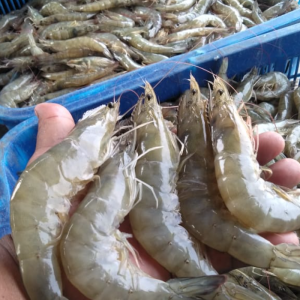
Transcriptomic Analysis of Pacific White Shrimp in Response to AHPND
| Fri, 25 Sep 2020 - 17:14
One of the primary bacterial infections affecting shrimp farming is Acute Hepatopancreatic Necrosis Disease (AHPND), formerly called Early Mortality Syndrome (EMS), which causes 90 to 100 percent mortality in affected shrimp ponds. The first and foremost shrimp organ infected by AHPND is the hepatopancreas, a crucial digestive gland involved in controlling systemic metabolism, digestion and storage of nutrients, and whose multiple physiological and immunological functions are affected during infection.
The causative agents of AHPND are bacteria of the genus Vibrio, with V. parahaemolyticus being the primary infection vector. This bacterium contains a plasmid (a small, extrachromosomal DNA molecule within a cell that is physically separated from chromosomal DNA and can replicate independently) involved in the production of lethal toxins that damage and destroy the shrimp hepatopancreas.
Although several molecular tools and histopathological tests have been developed and are currently available to detect AHPND, the physiological and biochemical alterations caused by AHPND in the organism are far from understood.
The differentially expressed microRNA [miRNAs are small RNA (nucleic acid molecule essential in various biological roles including regulation and expression of genes) molecules that act as key regulators of development, cell proliferation, differentiation and the cell cycle of Pacific white shrimp (Litopenaeus vannamei) in non-infected vs. infected shrimp with V. parahaemolyticus suggests that miRNAs modulate several immune processes during AHPND.
There has been considerable research to understand the biology and control of AHPND, but to date, there has not been a published transcriptional profile (a measurement of the expression of thousands of genes at once, to create a global picture of cellular function) of L. vannamei hepatopancreas with AHPND emulating the natural course of infection.
This article – adapted and summarized from the original publication – investigated the transcriptional mRNA response of the L. vannamei hepatopancreas during AHPND infection, to gain a better understanding of AHPND shrimp pathogenesis and to find new genomic (interdisciplinary biology field that focuses on the structure, function, evolution, mapping, and editing of genomes) approaches to address this aquaculture problem.
Study setup
Healthy L. vannamei (12.26 ± 0.022 grams) were maintained in 1000-liter tanks filled with filtered (1 μm) and aerated seawater, salinity of 35 PSU, at 25 degrees-C. Shrimp were acclimatized and fed to satiation daily for one week, with a commercial feed. V. parahaemolyticus was isolated and characterized from dying shrimp obtained from farms in Guasave, Sinaloa, Mexico.
Before bacterial challenge, the experimental shrimp were examined under the microscope to determinate molt stage. Animals in the intermolt stage were placed in 20-liter plastic tanks at 28 degrees-C and 35 ppt salinity under continuous aeration and left to acclimatize for three days. A total of 18 tanks (9 control and nine experimental) were set up with 10 shrimp per tank. Experimental infection was carried out using a bacterial concentration of 660 CFU (colony forming units)/mL per tank, and were exposed to the bacteria for at least 72 hours.
After bacterial exposure, hepatopancreas samples were collected at 0 hours (before infection), 3, 6, 12, 24 and 48 hours post-infection (hpi) for control and treated groups; samples were properly preserved and frozen for tests and analyses.
For detailed information on the experimental design and animals used; biological materials; histopathology and the various other tests carried out, refer to the original publication.
Results and discussion
In this study, we identified a significant number of differentially expressed transcripts, DETs, [transcription is the process of copying a segment of DNA (molecule carrying genetic instruction is cells) into RNA (molecule essential in various biological roles in coding, decoding, regulation and expression of genes)] and started to understand the molecular pathways that take place during AHPND.
We infected juvenile L. vannamei with AHPND positive V. parahaemolyticus by immersion. Following histopathological results at 12, 24, 48 and 72 hpi, a sequential progression of hepatopancreas lesions was observed in AHPND infected tissue. Our histopathological results agree with previous reports, with necrosis (unprogrammed cell death), epithelial cells sloughing, atrophy and massive hemocyte (cells involved in the immune system of invertebrates) infiltration signs were more evident from 48 hpi onwards.
In our differential expression analysis, a total of 915 transcripts were detected between the infected and non-infected control groups. The number of up-regulated genes [process by which a cell increases the quantity of a cellular component, such as RNA or protein, in response to an external stimulus] was considerable more (473) than the down-regulated genes [opposite process to up-regulation] (442), probably due to biological changes and inhibition of certain cellular functions caused by V. parahaemolyticus infection.
The L. vannamei innate immune system contains cellular and other components that work individually and synergistically to protect the organism integrity during infection. Activation of the shrimp immune response depends on diverse mechanisms that include the antioxidant system, hemolymph (fluid analogous to blood in arthropods – invertebrates with an external skeleton), wound repair and some proteins.
All living organisms produce the reactive oxygen species (ROS) during normal aerobic metabolism. Stress conditions like pH, temperature, hypoxia and microbial infections can shortage oxygen and increase ROS, resulting in oxidative stress within the cells. Increased levels of ROS causes macromolecules damage which in turn affect membranes and enzymes structure and nucleic acids integrity. The endogenous cellular defense mechanisms to stabilize increased levels of ROS include antioxidant molecules and enzymes. Our results showed 442 up-regulated transcripts which were grouped in different categories including oxidation-reduction processes, biological process (BP) and oxidoreductase activity for molecular function (MF).
Hemocyanin is an abundant protein present in the hemolymph of arthropods and mollusks and has the primarily function to transport and store molecular oxygen, along with other multiple physiological functions like protein storage, osmoregulation, molt cycle and others. Our results show that multiple isoforms (very similar proteins from a single gene or gene family) of L. vannamei hemocyanin (LvHCY) are present in both up and down-regulated transcript sets; also, that there is significant expression increase of LvHCY after 24 hpi compared to the control. And other authors have reported the toxin-neutralizing activity of hemocyanin against V. parahaemolyticus infection.
Among the first immune responses shrimp have to either fight against pathogens or to prevent loss of hemolymph during tissue damage is clotting. Our results indicate that the expression of a L. vannamei hemolymph protein (LvCLO) increases significantly at 3 hpi. And other studies with black tiger shrimp (Penaeus monodon) showed up-regulation of coagulation-related genes during stomach infection caused by V. parahaemolyticus. These findings show activation of the coagulation system is a fundamental step during bacterial infection.
Thrombospondins (THBSs) are a family of extracellular calcium-binding proteins, which in vertebrates are involved in several physiological processes. However, very little is known about the function of THBSs in invertebrates. In penaeid shrimp, it has been suggested that THBSs are part of the defense response against microbial infection, and our results suggest that they may be involved in the defense mechanism during AHPND.
One of the main enzymes involved in the production of glucose is the phosphoenolpyruvate carboxykinase (PEPCK), which under low oxygen conditions, helps keep glucose stable within the cells. Vibrio infections can decrease oxygen uptake during pathogenesis and induce hypoxia (oxygen deprivation). Cellular oxygen deprivation alters metabolic pathways resulting in a hypoxia response.
To prevent further damage due to low oxygen levels, cells protect themselves with a group of proteins called oxygen-regulated proteins. Our data shows that the hypoxia gene for L. vannamei, LvHYO, was up-regulated at six and 24 hours in the infected shrimp group. Over-expression of hypoxia genes in bacterial pathogenesis has been related to an increase in bacterial load during early AHPND stages and causing hepatopancreatic septicemia (blood poisoning by bacteria), probably due to the high levels of AHPND toxins in the cells.
Several studies have looked at the pathogen-host response in shrimp using either different shrimp species or pathogens. However, very few studies have investigated the shrimp immunological response at the transcriptome (all the RNA molecules in one cell or a population of cells) level. In addition to identifying genes involved in the host immune response, we also looked for genes that participate in metabolic pathways. Bacterial infections tend to modify their host metabolism via homeostasis disruption.
Based upon our analysis, we identified a new set of several differentially expressed metabolic genes, none of which have previously been reported as being differentially expressed during pathogen infection. Determining the function of these genes during the metabolic response will provide a deeper understanding of how the metabolic and immune system interact and work towards specific pathogens.
Perspectives
We built a novel transcriptome of L. vannamei hepatopancreas infected with V. parahaemolyticus (AHPND) at 24 hours and found a total of 915 differentially expressed transcripts, from which 442 were up and 473 were down-regulated.
Our results also suggest a close interaction between the hepatopancreas metabolism and immune system, indicating that both systems respond collectively against a V. parahaemolyticus infection.
Further studies are needed on how the metabolic and immunologic regulation works in shrimp during AHPND, because this knowledge can be the basis for designing therapeutic strategies.
Source: Global Aquaculture Alliance






















